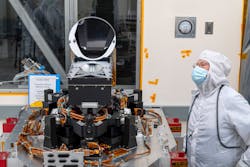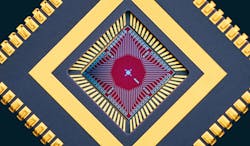Laser comms hitch a ride to deep space on Psyche spacecraft (UPDATED)
Editor's note: On November 14th, NASA’s DSOC experiment, which hitched a ride on the side of the Psyche spacecraft, just beamed down its first laser comms experiment from nearly 10 million miles (16 million kilometers) away—roughly 40x farther than the Moon is from Earth—to the Hale Telescope at Caltech’s Palomar Observatory in California. It sets a new record for the farthest-ever demonstration of optical comms.
NASA is poised to launch its Deep Space Optical Communications (DSOC) technology demonstration, on October 5, 2023, sending a near-infrared (NIR) transceiver along for the ride on the Psyche mission to explore whether lasers can help speed data transmission far beyond the capacity of the radio frequency (RF) systems currently used for space communications to deep space (see video).
While the mission to the misshapen-potato-looking Psyche metal asteroid may ultimately unveil secrets of how Earth’s core formed, during the first two years of the spacecraft’s journey, the DSOC transceiver (see Fig. 1) will communicate with two ground stations in California to test detectors, laser transmitters, and methods to decode signals sent from deep space.
“Historically, the data return capacity for NASA missions has grown by increasing the radio frequencies,” says Abi Biswas, supervisor for optical communications at NASA’s Jet Propulsion Laboratory. “Extrapolating it further into optical frequencies affords significant bandwidth expansion, and advances in lasers, detectors, actuators, and signal-processing technologies make it possible.”
NASA is turning to NIR laser comms, which like RF rely on electromagnetic waves to transmit data, because it can pack data into much tighter waves than RF systems to increase the amount of data ground stations can receive at once. In fact, DSOC’s NIR laser comms are designed to provide 10–100X the data-return capacity of state-of-the-art RF systems currently used in space.
High-bandwidth laser communications for near-Earth orbit and Moon-orbiting satellites are already proven, but deep space comms is a new frontier and presents a much bigger challenge.
“Designing laser/optical communications for planetary ranges covering Mars, Venus, and beyond is driven by the huge increase in distance compared to lunar ranges,” says Biswas. “Narrower laser beams, tighter pointing control, and the ability to detect fainter laser signals efficiently drive the design. We’ve also developed special techniques for squeezing as much information as possible out of each photon we detect.”
New technologies on display
The DSOC transceiver features a never-before-flown photon-counting camera (see Fig. 2), built by MIT Lincoln Laboratory, which is attached to a 22-centimeter (8.6-inch) aperture telescope mounted onto the side of the Psyche spacecraft on struts and actuators to stabilize the optics from any spacecraft vibrations. It’s designed to autonomously scan for and lock onto the high-power NIR laser uplink transmitted by the Optical Communications Telescope Laboratory in Table Mountain, California (see Fig. 3).
“Photon counting detects faint signals from deep space distances and is implemented on both ends of the link,” explains Biswas. “On the space side, a photon-counting camera detects a ‘dim’ laser signal transmitted from Earth, which serves as a pointing reference for downlink laser pointing from space to Earth—it supports kilobit-per-second uplink communications. On the ground, a photon-counting detector array is used to ‘time-tag’ photon arrivals. Processing these time tags in near real-time enables extracting information at megabits-per-second data rates from Mars distances.”
Once locked onto the uplink laser, the DSOC transceiver will locate the 5.1-meter (200-inch) Hale Telescope at Caltech’s Palomar Observatory, about 100 miles (130 kilometers) south of Table Mountain. The transceiver’s NIR laser will then transmit high-rate data down to Palomar.
The Hale Telescope is equipped with a superconducting nanowire single-photon detector assembly, which is cryogenically cooled so that a single incident laser photon can be detected and its arrival time recorded. For perspective on how amazing this is: Laser light is transmitted as a train of pulses that travel more than 300 million kilometers (186 million miles) before its faint signals can be detected and processed to extract information.
Deep space challenges
The massive distance to transmit data to/from deep space is incredibly daunting, and link acquisition and tracking over these huge distances results in “relatively high transverse velocities and long round-trip light times, so we need to correct pointing errors describing Einstein’s theory of special relativity,” says Bill Klipstein, the project manager at NASA’s Jet Propulsion Laboratory.
How challenging is this? Biswas likens it to trying to hit a dime from a mile away while both the dime and person trying to hit it are moving at high speed.
“Our design to overcome this formidable problem is to exchange laser signals between ground and space (see Fig. 4), while actively tracking out errors with relatively low bandwidth control, and also isolating or damping from high-frequency disturbances,” he says. “Residual errors must be reduced to acceptable levels to allow high-rate communications.”
And as you might expect, one of the most surprising aspects of this project is the “rich multidisciplinary scope of work resulting in interactions with diverse subject matter experts, accompanied with a continuing learning process,” says Biswas. “It was rewarding and cool.”
DSOC mission milestones
The DSOC technology demonstration has many demonstration goals, including: Demonstrate that the flight laser transceiver and ground systems can lock onto each other’s laser signals during DSOC’s calibration and commissioning phase; demonstrate specified downlink data rates as the Psyche spacecraft travels farther away from Earth (data rates decrease with increasing distance); demonstrate a data uplink up to a distance of 1 astronomical unit (AU; 150 million kilometers/93 million miles); and demonstrate operations for two years from the time of the Psyche mission launch at a cadence of one to two contacts per week for the duration of the demonstration (which is intended to be two years, but may be extended).
While uplink communications of 1 AU is specified for the technology demonstration, beacon services are needed for the 2 AU range really being targeted by DSOC. The laser transmitted from the ground both serves as a pointing reference beacon and a low-data-rate carrier.
“Our DSOC technology demonstration and validation will pave the way toward an optical operational capability in the near term. In the relatively near term, developing ground infrastructure for future NASA missions while scaling performance to satisfy the demands of human missions for navigation and light science will be a natural extension of services,” says Biswas. “As a longer-term goal, operating optical communications without the assistance of a ground-transmitted laser, especially for missions to outer reaches of the solar system, can be expected.”
A quick shout-out to the DSOC technology demonstration partners: L3Harris SSG Inc. for the optical transceiver assembly; Controlled Dynamics Inc. for the isolation pointing assembly struts; CACI for the laser transceiver assembly; MIT Lincoln Laboratory for the photon counting camera; Fibertek for the uplink laser assembly; and First Mode for the aperture cover.
About the Author
Sally Cole Johnson
Editor in Chief
Sally Cole Johnson, Laser Focus World’s editor in chief, is a science and technology journalist who specializes in physics and semiconductors.




